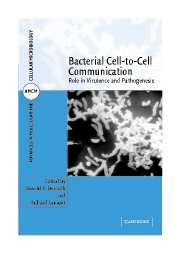Book contents
- Frontmatter
- Contents
- List of Contributors
- Preface
- 1 Quorum sensing and regulation of Pseudomonas aeruginosa infections
- 2 The Pseudomonas aeruginosa quinolone signal
- 3 Quorum-sensing-mediated regulation of plant–bacteria interactions and Agrobacterium tumefaciens virulence
- 4 Jamming bacterial communications: new strategies to combat bacterial infections and the development of biofilms
- 5 Quorum-sensing-mediated regulation of biofilm growth and virulence of Vibrio cholerae
- 6 LuxS in cellular metabolism and cell-to-cell signaling
- 7 LuxS-dependent regulation of Escherichia coli virulence
- 8 Quorum sensing and cell-to-cell communication in the dental biofilm
- 9 Quorum-sensing-dependent regulation of staphylococcal virulence and biofilm development
- 10 Cell-density-dependent regulation of streptococcal competence
- 11 Signaling by a cell-surface-associated signal during fruiting-body morphogenesis in Myxococcus xanthus
- Index
- Plate Section
- References
10 - Cell-density-dependent regulation of streptococcal competence
Published online by Cambridge University Press: 08 August 2009
- Frontmatter
- Contents
- List of Contributors
- Preface
- 1 Quorum sensing and regulation of Pseudomonas aeruginosa infections
- 2 The Pseudomonas aeruginosa quinolone signal
- 3 Quorum-sensing-mediated regulation of plant–bacteria interactions and Agrobacterium tumefaciens virulence
- 4 Jamming bacterial communications: new strategies to combat bacterial infections and the development of biofilms
- 5 Quorum-sensing-mediated regulation of biofilm growth and virulence of Vibrio cholerae
- 6 LuxS in cellular metabolism and cell-to-cell signaling
- 7 LuxS-dependent regulation of Escherichia coli virulence
- 8 Quorum sensing and cell-to-cell communication in the dental biofilm
- 9 Quorum-sensing-dependent regulation of staphylococcal virulence and biofilm development
- 10 Cell-density-dependent regulation of streptococcal competence
- 11 Signaling by a cell-surface-associated signal during fruiting-body morphogenesis in Myxococcus xanthus
- Index
- Plate Section
- References
Summary
INTRODUCTION
A brief history
In the 1920s Frederick Griffith, a medical officer at the Ministry of Health in Britain, made a significant discovery regarding Streptococcus pneumoniae, a bacterium that caused a pneumonia epidemic in London. While examining the strain variability within different groups of pneumococci, Griffith noted that an avirulent strain of the bacterium could revert to the virulent type or remain unchanged following subculture (37). Because this phenomenon enabled the bacterium to acquire a novel heritable phenotype, Griffith coined the term “transformation principle” to describe the phenotypic changes he observed.
In his classic experiment, Griffith studied a highly infective, encapsulated S strain that formed smooth colonies, and an avirulent R strain, which had no capsule and formed rough colonies when grown on blood agar (37). When healthy mice were injected with the S strain, they died of septice- mia, whereas separate admission of the R strain or the heat-killed S strain appeared to be harmless. However, when the live R strain and the heat-killed S strain were injected simultaneously, the mice died. Surprisingly, when blood samples drawn from these dead animals were analyzed, both R and S live strains were detected. Based on these results, Griffith concluded that a “transforming factor”, present in the heat-killed S strain, was able to “transform” an avirulent R strain into a capsulated, virulent S strain.
Over the next few decades, Griffith's inspiring work on transformation was followed up by a number of scientists.
- Type
- Chapter
- Information
- Bacterial Cell-to-Cell CommunicationRole in Virulence and Pathogenesis, pp. 233 - 268Publisher: Cambridge University PressPrint publication year: 2006



